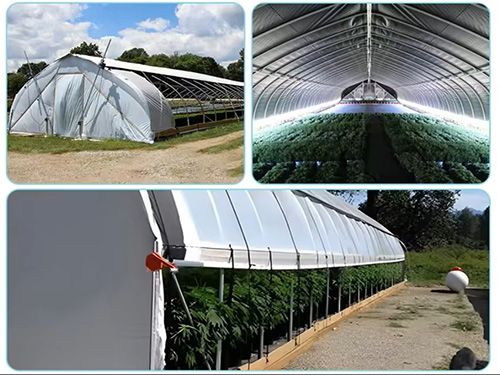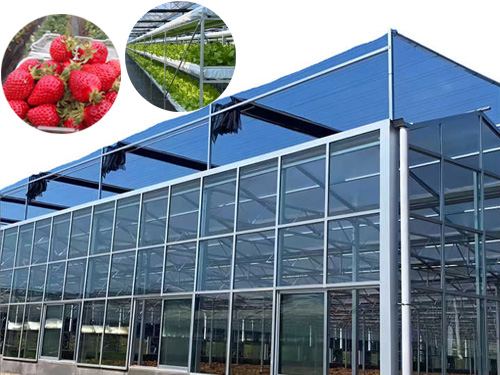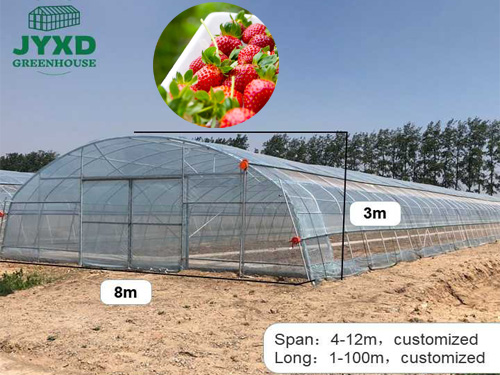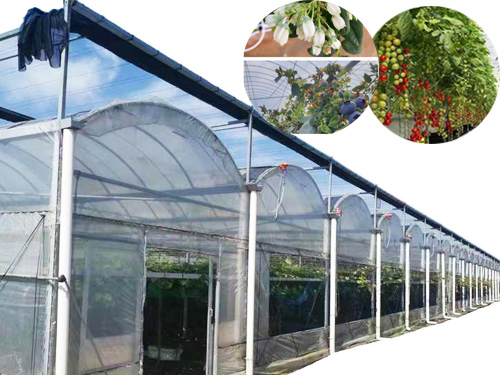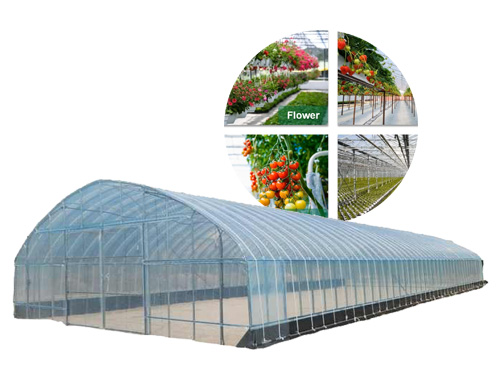NEWS DETAILS
NEWS INFORMATION
Using Biological Pesticides in Greenhouses: Protecting Plants from Pests Naturally
AUTHOR:jyxd-greenhouse DATE:2025-03-25 11:47:51 HITS:129
As global awareness about sustainability and environmental impact increases, more greenhouse farmers are shifting towards natural solutions for pest control. One such solution gaining traction is the use of biological pesticides, which provide an eco-friendly alternative to conventional chemical pesticides. By utilizing beneficial organisms to protect crops, biological pesticides help reduce the risk of harmful chemical residues in food, minimize environmental damage, and promote biodiversity. In this article, we will explore the benefits of using biological pesticides in greenhouses, how they work, and the different types available to greenhouse growers.
What Are Biological Pesticides?
Biological pesticides, often referred to as biopesticides, are derived from natural materials such as plants, bacteria, fungi, or other organisms. Unlike traditional chemical pesticides, which can have harmful effects on the environment, human health, and non-target organisms, biological pesticides offer a safer and more sustainable way to control pests in greenhouse environments. These natural solutions work in various ways, such as by targeting pest life cycles, inhibiting pest growth, or attracting beneficial predators to the area.
Biological pesticides can be divided into three main categories:
1. Microbial Pesticides: These are derived from bacteria, fungi, viruses, or other microorganisms. They target specific pests without affecting other organisms. For example, Bacillus thuringiensis (Bt) is a common bacterium used to control caterpillars.
2. Biochemical Pesticides: These are naturally occurring substances that control pests through non-toxic mechanisms. For example, pheromones are used to disrupt mating patterns in pests, reducing their population.
3. Plant-Incorporated Protectants (PIPs): These are derived from plants that have been genetically modified to produce compounds that protect against specific pests. While still a developing field, PIPs offer potential for long-term pest management.
Benefits of Using Biological Pesticides in Greenhouses
1. Environmentally Friendly
One of the most significant advantages of using biological pesticides in greenhouses is their minimal environmental impact. Unlike synthetic chemicals that can leach into the soil or water systems, biological pesticides are biodegradable and typically break down quickly without leaving harmful residues. This means that they do not pollute the environment or harm beneficial insects, such as pollinators and natural predators, which are vital for maintaining ecosystem balance.
2. Targeted Pest Control
Biological pesticides are highly specific to the pests they target, meaning they often do not affect non-target organisms. This specificity reduces the risk of harming beneficial insects, birds, and other wildlife that may interact with the greenhouse environment. For instance, Bt bacteria specifically target caterpillars and are harmless to other insects, such as bees and ladybugs, which are beneficial for pollination and pest control.
3. Reduced Resistance Development
Pests can develop resistance to chemical pesticides over time, making them less effective. Biological pesticides, on the other hand, often work through natural processes that are harder for pests to resist. By disrupting pests’ life cycles or introducing beneficial organisms, biological pesticides create an ongoing challenge for pests, reducing the likelihood of resistance. This makes them an essential part of integrated pest management (IPM) programs that combine multiple pest control strategies for long-term effectiveness.
4. Safer for Humans and Animals
Traditional chemical pesticides can pose health risks to humans and animals if not used correctly. Residual pesticide chemicals on crops can enter the food supply, causing potential harm to consumers. Biological pesticides are generally considered safe for humans, animals, and other non-target organisms, making them an ideal choice for greenhouse farming. When used correctly, biopesticides leave little to no residue, ensuring that food produced in greenhouses is safe for consumption.
5. Promotes Biodiversity
The use of biological pesticides encourages the use of natural predators and beneficial insects in the greenhouse. For example, releasing predatory insects like ladybugs, lacewings, and parasitic wasps can naturally control pest populations. This promotes a healthier, more balanced ecosystem within the greenhouse and supports biodiversity. By fostering the presence of diverse organisms, biological pesticides help maintain a natural pest control cycle and reduce the need for chemical interventions.
How Biological Pesticides Work in Greenhouses
Biological pesticides work in various ways, depending on the type of pest and the method of application. Here are some common ways in which biopesticides protect crops in greenhouses:
1. Direct Predation
Many biological pesticides rely on the introduction of natural predators to control pest populations. For instance, releasing ladybugs in a greenhouse can help reduce aphid populations, as ladybugs feed on aphids. Similarly, predatory mites can be introduced to control spider mites, while parasitic wasps can attack pest larvae, preventing them from maturing and causing damage.
2. Pathogenic Infections
Microbial pesticides, such as bacteria, fungi, and viruses, infect pests and cause diseases that lead to their death. For example, Bacillus thuringiensis (Bt) produces a protein that disrupts the digestive system of certain insects, leading to their death. Similarly, beneficial fungi like Beauveria bassiana can infect and kill various pest insects, including whiteflies and thrips.
3. Disruption of Reproduction
Some biological pesticides work by disrupting the mating behaviors of pests. Pheromone-based biopesticides are commonly used to confuse male insects and prevent them from finding mates, thereby reducing the pest population. This method is particularly effective for pests like moths, where pheromones can be used to disrupt the breeding cycle and lower pest numbers.
4. Natural Repellents
Certain plant-based biopesticides act as natural repellents, keeping pests away from crops. These substances are often derived from essential oils or plant extracts and can be sprayed onto crops to repel insects or other pests. For example, neem oil, extracted from the neem tree, is widely used as a natural pesticide to repel a range of pests, including aphids, whiteflies, and beetles.
Popular Biological Pesticides for Greenhouses
Several biopesticides have proven effective in greenhouse farming. Here are some commonly used biological pesticides:
1. Bacillus thuringiensis (Bt)
Bt is a widely used microbial pesticide that targets the larvae of many insect pests, such as caterpillars, mosquitoes, and beetles. It works by producing toxins that cause the insect to stop feeding and eventually die.
2. Neem Oil
Neem oil, derived from the neem tree, acts as both an insect repellent and a fungicide. It is effective against a variety of pests, including aphids, whiteflies, and spider mites, and can also help control fungal diseases like powdery mildew.
3. Beauveria bassiana
This beneficial fungus infects and kills pests such as aphids, whiteflies, and thrips. It is often used in greenhouse environments to control these hard-to-manage pests without harming beneficial insects.
4. Spinosad
Spinosad is a natural insecticide derived from bacteria found in the soil. It is effective against a range of pests, including thrips, caterpillars, and leafminers. It works by targeting the nervous system of the pest, leading to paralysis and death.
Conclusion
Biological pesticides offer an effective, eco-friendly solution for controlling pests in greenhouse environments. By leveraging natural predators, microbial pesticides, and plant-based repellents, greenhouse growers can protect their crops while minimizing the use of harmful chemicals. Not only do biological pesticides help maintain the health of crops, but they also promote a more sustainable and biodiverse farming system. As the demand for organic and sustainable produce continues to rise, the use of biological pesticides will play an essential role in shaping the future of greenhouse farming.
Hebei Juyou Xinda Greenhouse Facilities Co.,Ltd.
Copyright © 2024-2025 https://www.jyxd-greenhouse.com. All Rights Reserved Hebei Juyou Xinda Greenhouse Facilities Co.,Ltd.Copyright





 Current Location:
Current Location:


